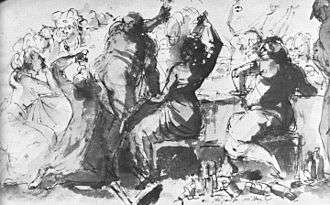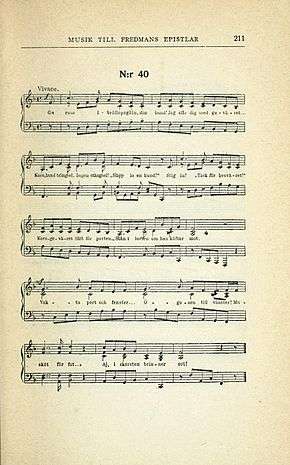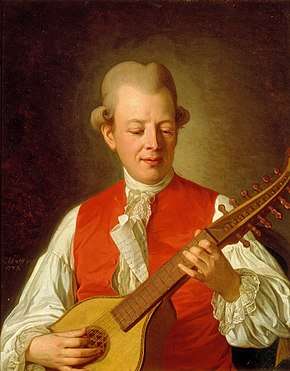Ge rum i Bröllopsgåln din hund!
Ge rum i Bröllopsgåln din hund! (Make room in the Wedding reception you dog!), is one of the Swedish poet and performer Carl Michael Bellman's best-known and best-loved songs, from his 1790 collection, Fredman's Epistles, where it is No. 40. The song describes an utterly chaotic wedding at a venue with soldiers mixed up with musicians and the wedding-party; the chimney catches fire, and even the priest robs the collection.

The epistle is subtitled "Angående Bröllopet hos Bensvarfvars" (Concerning the Wedding at Bensvarvars).
Context
Carl Michael Bellman is the central figure in Swedish song, known for his 1790 Fredman's Epistles and his 1791 Fredman's Songs. He played the cittern, accompanying himself as he performed his songs at the royal court.[1]
Jean Fredman is a fictional character and the supposed narrator in Bellman's epistles and songs, based on a real watchmaker of Bellman's Stockholm.[2] The epistles paint a picture of the demimonde life of the city during the eighteenth century, where strong drink and beautiful "nymphs" like Ulla Winblad create a rococo picture of life, blending classical allusion and pastoral description with harsh reality.[1][2]
Song

The song has 9 verses, each of 14 lines. The verses have a complex pattern of stresses and rhyming pattern, ABCCABBDDEFFEE, contributing to the humorously chaotic effect.[3] The music is in 4
4 time, and is marked Vivace.[4] The Epistle is dated 10 October 1771. The source of the melody has not been identified.[5]
The song describes an utterly chaotic wedding at a venue with soldiers mixed up with musicians and the wedding-party; the chimney catches fire, and even the priest robs the collection.[4]
Reception
The Epistle is described by the musicologist James Massengale as "of one of the wildest weddings in Swedish literature". He comments that the rhyming pattern effectively hides some of the rhymes, making the descriptive poem imitate prose. Firstly, Bellman does not rhyme the first two lines until lines 5 and 6, when the verse is well under way. Next, he ignores the fact that the music repeats from bar 5, but creates new rhymes and divisions of the music in lines 5-10. To break up the order still further, he interjects short sharp commands, with "Stig in!" (Come in!) at the start of line 6 of the first verse, "Håll," (Halt!) at the start of line 11 in the second verse, "Alarm!" at the start and "Skyldra," (Shoulder arms!) in line 13 of verse 3, and "Gevär!" (Arms!) at the very beginning of verse 4. Massengale observes that these syntactic breaks destroy the listener's sense of position in the rhyming scheme, the uncertainty of the rhyme creating a feeling of the tumult of the chaotic wedding celebrations.[3]
The Bellman Society describes it as "The catastrophic wedding at Bensvarvars, a pub in Södermalm, is a tumult that is developed at breakneck tempo. It starts with a chimney fire and ends with a resounding brawl where the officiating priest helps himself to the collection for a hospital."[6]
Epistle 40 has been recorded by Sven-Bertil Taube and Cornelis Vreeswijk among others.[7] It has been translated into German.[8]
References
- "Carl Michael Bellmans liv och verk. En minibiografi (The Life and Works of Carl Michael Bellman. A Short Biography)" (in Swedish). The Bellman Society. Retrieved 25 April 2015.
- Britten Austin, 1967. Pages 61–93.
- Massengale, pages 112–116
- Bellman, 1790.
- Massengale, page 180.
- "Om Fredmans epistlar och sånger". The Bellman Society. Retrieved 22 March 2016.
- Hassler, page 284.
- Hensel, Jörg. "Bellman mit Berlina Schnauze". UHR-Verlag. Retrieved 22 March 2016.
Sources
- Bellman, Carl Michael (1790). Fredmans epistlar. Stockholm: By Royal Privilege.
- Britten Austin, Paul. The Life and Songs of Carl Michael Bellman: Genius of the Swedish Rococo. Allhem, Malmö American-Scandinavian Foundation, New York, 1967. ISBN 978-3-932759-00-0
- Britten Austin, Paul. Fredman's Epistles and Songs. Stockholm: Proprius, 1990 and 1999.
- Hassler, Göran; Peter Dahl (illus.) (1989). Bellman – en antologi [Bellman – an anthology]. En bok för alla. ISBN 91-7448-742-6. (contains the most popular Epistles and Songs, in Swedish, with sheet music)
- Hassler, Göran; Peter Dahl (illus.) (1989). Bellman II – en antologi [Bellman – an anthology]. En bok för alla. ISBN 91-7448-837-6.CS1 maint: multiple names: authors list (link) (contains the remaining Epistles and Songs, in Swedish, with sheet music)
- Kleveland, Åse; Svenolov Ehrén (illus.) (1984). Fredmans epistlar & sånger [The songs and epistles of Fredman]. Stockholm: Informationsförlaget. ISBN 91-7736-059-1.CS1 maint: multiple names: authors list (link) (with facsimiles of sheet music from first editions in 1790, 1791)
- Massengale, James Rhea (1979). The Musical-Poetic Method of Carl Michael Bellman. Stockholm: Almqvist & Wiksell International. ISBN 91-554-0849-4.
